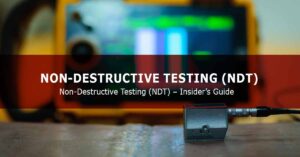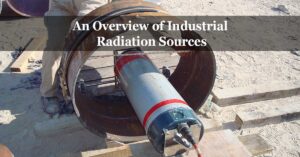NDT personnel’s qualifications and capabilities play a crucial role in determining the effectiveness of nondestructive testing. NDT personnel certification and training are essential to provide individuals with a technical understanding of the nondestructive equipment and the proper testing and evaluation procedures. Generally, NDT personnel must be trained, experienced, and certified to perform the test of a specific nondestructive method(s).
NDT Certification Programs
There are two types of approaches to certifying NDT personnel. The first approach is through Personnel Central Certification. The certification will be valid for the individuals, and it is not linked with their employment contract or location; hence, the individuals retain the certificate wherever they are employed. The common personnel central certification programs are:
- American Society for Nondestructive Testing (ASNT): provides two levels of certifications “Level II and Level III).
- ASNT Central Certification Program (ACCP): provides two levels of certifications “Level II and Level III).
- CSWIP (NDT): provides three levels of certifications “Level I, Level II, and Level III).
- ISO 9721 (Superseded EN 473): provides three levels of certifications “Level I, Level II, and Level III).
The second approach of NDT personnel certifications is called the employer-based certification. The certificate remains valid as long as the individual remains employed in the particular organization; the certificate automatically expires whenever the individual is leaving the organization.
The common standards for employer-based certification programs are:
- ASNT-SNT-TC-1A
- ANSI/ASNT CP-189
Levels of NDT Certifications
The three basic levels of NDT personnel qualifications are as follows:
NDT Level I
An NDT Level I individual is the personnel who is trained and qualified to perform specific NDT testing for one method or several methods. NDT Level I individuals should be capable and qualified to perform the testing method with proper utilization of testing method equipment, perform the necessary calibrations, evaluate the test result according to the written procedure, and record the final results.
An NDT Level I individual should work under close supervision from a certified NDT Level II or III individual to provide him with the necessary instructions and guidance.
NDT Level II
An NDT Level II individual is the personnel who is trained and qualified to understand the specific testing method or methods thoroughly. NDT Level II individual should be capable and qualified to calibrate the testing equipment, understand the methods’ scope and limitations, evaluate the test result according to the acceptance criteria and applicable standards, and review the results record performed by NDT Level I individual.
An NDT Level II individual handles training and supervising an NDT Level I personnel and provides the necessary job training.
NDT Level III
An NDT Level III individual is the personnel who is trained, qualified, and capable to develop, qualify, and approve NDT testing procedures, including all the necessary techniques, acceptance criteria, and necessary work instructions. An NDT Level III individual is the person who selects the suitable NDT testing method for a specific job or project.
An NDT Level III individual usually handles the NDT operations of an organization where the development of procedure and interpreting and evaluating results is necessary for proper compliance with specific code, standards, or specifications. Level III individual should have a broad practical experience in material types and grades, good experience in fabrication and production, and in-depth knowledge of various NDT methods to generate the necessary work procedure and testing techniques.
Level III individual handles the responsibility of training, examining, and certifying NDT Level I and II individuals for the NDT testing methods in which Level III individual is certified.
What is the difference between NDT Qualification and Certification?
Qualification is the ability of an NDT individual to perform an NDT correctly. Qualified NDT individual is resulting from education, training, and experience.
Certification is written testimony that the NDT individual has to pass, demonstrating his qualification and experience and meeting the minimum standard of education and training.
What is SNT-TC-1A? What are the benefits and limitations of SNT-TC-1A?
SNT-TC-1A is a practice standard that provides recommendations for the qualification and certification of NDT personnel. The employer is permitted to modify the recommendations of SNT-TC-1A to match his organization’s requirements. Each company develops its written practice that suits the organization’s operational requirement; therefore, its written practice must be reviewed in advance.
SNT-TC-1A describes three categories of qualification for individuals engaged in NDT: Level I, Level II, and Level III. The responsibilities of each level are as previously discussed.
Level I, II, and III personnel must be recertified periodically depending on the code edition and specification; Usually, level I, II, and III personnel recertify every five years.
Benefits of SNT-TC-1A
- The standard provides a basic certification approach that can be referenced in developing a company’s written practices.
- The standard implies customer responsibility to review and evaluate the written practice to ensure its adequacy with project or contract obligations.
- The standard offers the employer the flexibility to modify the certification requirements to meet specific needs.
- If the standard’s qualification concept is followed, it will result in significant training activity and personnel development in preparation for certification.
Limitations of SNT-TC-1A
SNT-TC-1A provides a recommended practice for every company to develop its written practices that suit the company’s purpose. The result is that most companies have different written practices for the certification, which may compromise the technicians’ qualification level. Besides, it may cause difficulties for organizations that purchase NDT services from NDT providers to ensure their requirements will be fulfilled unless they carefully evaluate the written practices.
Another limitation of SNT-TC-1A that the NDT individual’s certifications are terminated upon leaving the company.
What is the difference between SNT-TC-1A and ANSI/ASNT CP-189?
SNT-TC-1A is a recommended practice that sets guidelines for organizations to develop their written practices. ANSI/ASNT CP-189 standard addresses the uniformity in employer-based certification programs by setting precise minimum requirements.
CP-189 is based on SNT-TC-1A; however, CP-189 provides the minimum requirements of employer certification program, including the minimum requirements for education, training, experience, and examinations that must be met to be considered for certification. In contrast with SNT-TC-1A, the employer cannot deviate from the minimum certification requirements. In general, CP-189 offers an employer-based certification standard that addresses many of the perceived weaknesses of SNT-TC-1A.
CP-189 describes five categories of qualification for individuals engaged in NDT: Trainee, Level I, Level II, Level III, and NDT instructor. The responsibilities of Level I, Level II, and Level III is as previously discussed.
The trainee is the individual who is in the process of being trained, qualified, and certified. NDT instructor is a qualified instructor who provides NDT training. As per CP 189, the instructor must have a current ASNT Level III certificate in the method being instructed. However, the requirement can be waived with a certain education level and years of experience in the method being instructed.
What is the difference between ACCP Level III and ASNT NDT Level III?
The ASNT Central Certification Program (ACCP) requirements build upon the existing ASNT Level III certification program in whatever related to administered written tests. However, the ACCP Professional Level III candidate should demonstrate proficiency on a hands-on Level II (all techniques) and the capability to produce the necessary written procedure and examination preparation.
Therefore, ASNT NDT Level III professional is a certified individual how has to pass basic and method written examinations successfully as per the ASNT NDT Level III program. ACCP NDT Level III professional is ASNT NDT Level III, who has upgraded his certificate by completing the procedure preparation of all NDT techniques as per the ACCP NDT Level III program.
An ACCP NDT Level III individual can be certified in five methods: magnetic particle testing (MT), liquid penetrant testing (PT), radiographic testing (RT), ultrasonic testing (UT), and visual testing (VT). The ACCP NDT Level III certificate is valid for a maximum of five years.
References:
- ASNT-SNT-TC-1-A-2020.
- Nondestructive Examination (NDE) Technology and Codes Student Manual.
- American Society for Nondestructive Testing ASNT.







